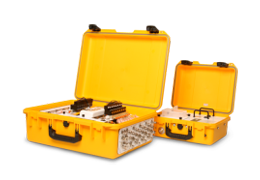Printable PDF: Making CO2 Profile Measurements with the LI-8100A and LI-8150 System
Instructions for profile measurements.
The LI-8100A Automated Soil CO2 Flux System has been designed to help answer the spatial and/or temporal variability questions that arise when performing soil CO2 flux measurements. When using the LI-8150 Multiplexer with the LI-8100A Analyzer Control Unit, you can expand your research by performing atmospheric CO2 profile measurements at minimal added cost. This application note provides a brief theory on CO2 profiling measurements and explains the LI-8100A hardware requirements and setup, as well as software configuration.
Theory
Eddy covariance and other micrometeorological techniques measure the flux of CO2 (FCO2) across a horizontal plane at the instrument height; however, the research community is interested in understanding the net ecosystem CO2 exchange (NEE) of the underlying surface. When the boundary layer is well mixed, the flux from the surface is equal to the flux measured at the instrument level, giving the following:
1NEE = FCO2
However, during periods with reduced exchange between canopy and the atmosphere (low winds, thermally stable conditions, transition periods, etc.) the total mass of CO2 in the air column beneath the instrument is not constant. For example, during low winds at night, CO2 can build up beneath the measurement level to be released later, with a gust of wind or due to a change in thermal stratification, from stable to unstable in the morning. Under such conditions, a CO2 storage term must be accounted for in order to estimate NEE from the eddy covariance flux measurements (Baldocchi et al., 2001). Thus, equation 1 transforms to the following:
2NEE = FCO2 + S
where S is the storage term representing the change in CO2 mass in the air column from ground (z = 0) to the instrument height z. It can be estimated from the data from a CO2 profile measurement, and expressed as:
3
LI-8100A system requirements
The modular design of the LI-8100A System allows for both soil CO2 flux and atmospheric CO2 profiling studies to be performed simultaneously. There are three components needed for CO2 profiling studies: (1) the LI-8100A Analyzer Control Unit, which performs the gas analysis and serves as the data and communication center; (2) the LI-8150 Multiplexer, which is available with eight (LI-8150-8) or sixteen (LI-8150-16) ports and is used to connect the 8100-101 and/or 8100-104 long-term chambers; and (3) the CO2 profiling parts, which are included in a profile kit (part #8150-662). Each kit allows up to 4 ports to be used for atmospheric profiling measurements. If the number of long-term chambers connected to the LI-8150 Multiplexer is less than the number of ports available, then you can use the remaining ports for CO2 profile measurements.
Tubing distance, response time, and appropriate software setup must be considered when using the LI-8100A System for CO2 profiling. We measured the response time of the LI-8100A System using 1/8 inch ID Bev a-line tubing of different lengths. Table 1 contains a summary of the response time for the LI-8150 Multiplexer when used for CO2 profile measurements. Response time is defined as the amount of time it takes for CO2 to reach 95% of a new value. We tested three flow rates (high, medium, and low) and three tubing lengths.
We recommend a maximum tubing length of 45 meters for profile measurements due to pump limitations and response times. The air flow from the profile measurement can be exhausted inside the LI-8150 case by disconnecting the outlet tubes at the quick connect union (Figure 1 and Figure 2) of each port used for a profile measurement. During a profile measurement, the outlet port on the outside of the LI-8150 case can be covered by a vinyl cap (part # 620-08298) to prevent dust and debris from entering the system. These caps are included in the 8150-662 Profiling Kit. The pressure relief valve (Figure 3) on the LI-8150 case will prevent excessive pressure from building up inside the LI-8150.
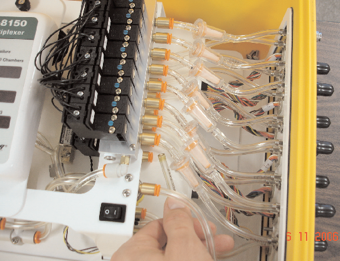
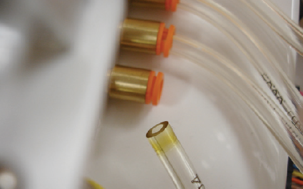

Software configuration
The LI-8100A interface software must be configured to support profiling. The port sequence is very flexible. For example, if you wish to have four profile ports (1,2,3,4) and four chamber ports (5,6,7,8) they can be used in any sequence or combination. You may wish to measure the profile ports between each chamber measurement. In that case, the sequence might be: 5,1,2,3,4,6,1,2,3,4,7,1,2,3,4,8,1,2,3,4. Any other sequence could also be defined (e.g., 1,2,3,4,5,6,7,8).
Now we configure the ports used for profile measurements. The response times for sequential profile measurements should be as short
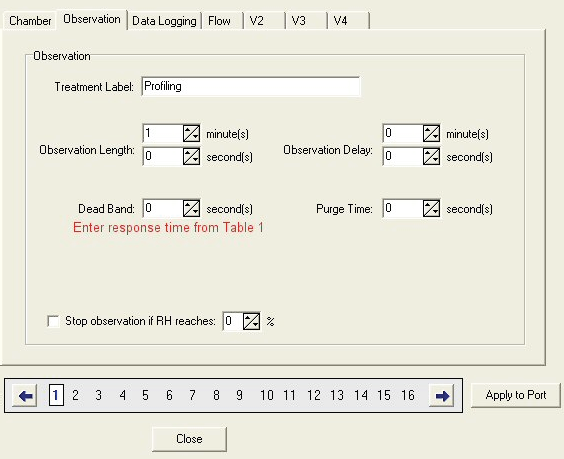
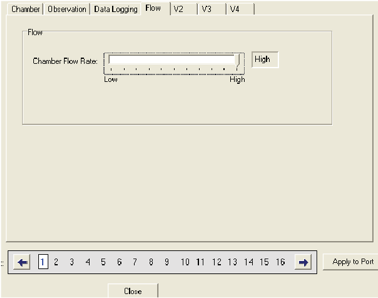
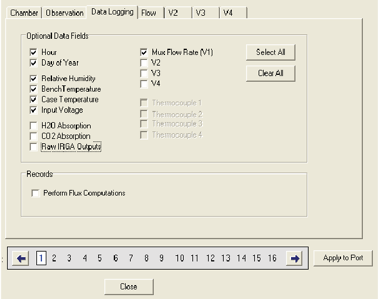
as possible. An Observation Length of one minute will often be adequate for each profile measurement (Figure 4). Set the Deadband to equal the appropriate response time listed in Table 1. The time remaining after the deadband is satisfied can be used to acquire the mean CO2 concentration. Set the LI-8150 flow rate to High to provide faster response times (Figure 5).
Finally, the CO2 flux calculation becomes unnecessary when setting up ports for profile measurements. You should clear the Perform Flux Computations box so only raw data are collected during a profile measurement (Figure 6). With these changes implemented, you can download and review the data file in the same manner as if taking normal soil CO2 flux measurements. The LI-8100 files can then be exported from File Viewer to obtain the mean CO2 concentrations from each observation.
Conclusions
The LI-8100A System provides the flexibility to measure soil CO2 flux with up to 16 chambers. Alternatively, some or all of the ports on the LI-8150 can be used to measure the CO2 profile in the atmosphere in any combination with soil CO2 flux measurements using chambers. In this note we describe the limitations, response time, and software settings necessary to support atmospheric CO2 profile measurements.
A kit that includes the necessary tools for four profile ports is available (part #8150-662). This kit includes profiling vents, as well as fittings that can be used to connect air sampling lines to the LI-8150 (300-07124). Vinyl plugs (620-08298) to seal the outlet port of the multiplexer when performing a profile measurement are also included. Bev-a-line tubing is sold separately, as each user may require different lengths of tubing.
| Atmospheric Profiling Kit | 8150-662 (4 ports) |
|---|---|
| Profiling Vent | 9981-149 (x4) |
| Quick Connect | 300-04124 (x4) |
| Vinyl Plug | 620-08298 (x4) |
| Bev-a-line sold separately (part # 8150-250; 15 m roll) | |
| Quick-connect unions sold separately (part # 300-03123); to connect Bev-a-line together | |
For additional information regarding atmospheric CO2 profile measurements, contact LI-COR at 1-800-447-3576, or envsupport@licor.com.
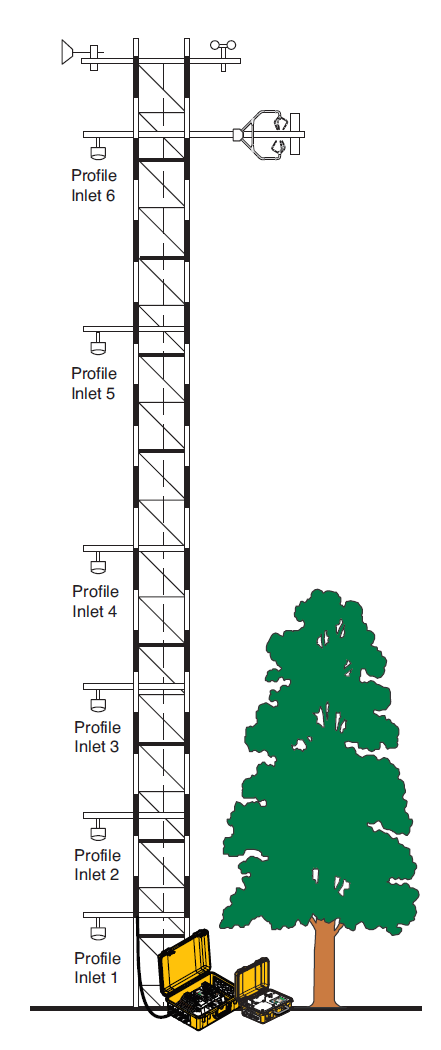
References
| 1 | Baldocchi, D. Dennis, et al., 2001. FLUXNET: a new tool to study the temporal and spatial variability of ecosystem-scale carbon dioxide, water vapor and energy flux densities. Bull. Am. Meteorol. Soc. 82. 2415-2434. |
| 2 | Lee, Xuhui, 1998. On Micrometeorological observations of surface-air exchange over tall vegetation. Agric. For. Meteorol. 91. 39-49. |
